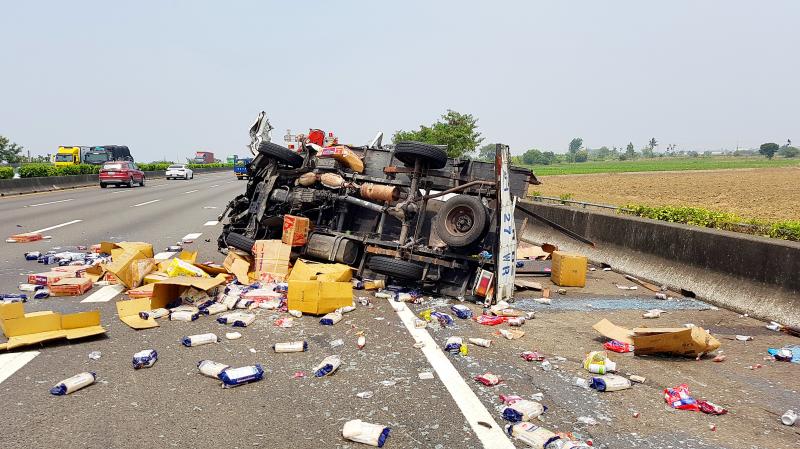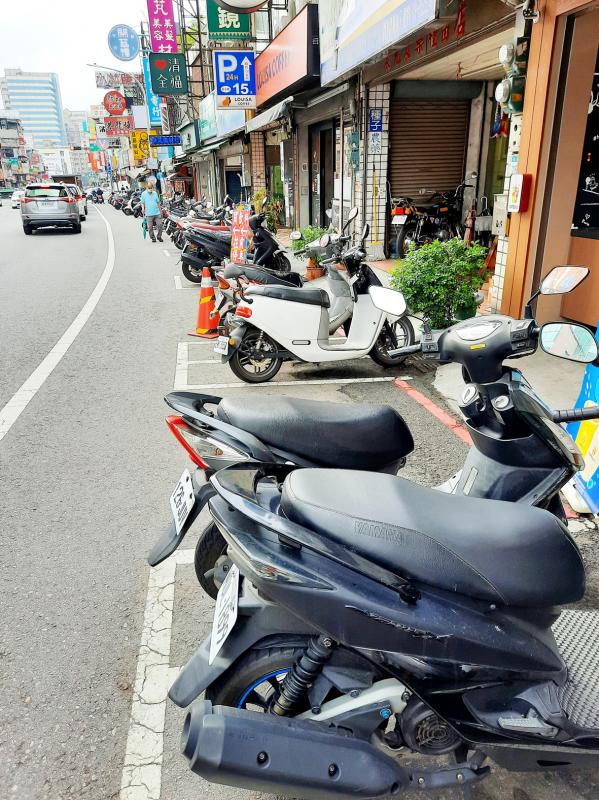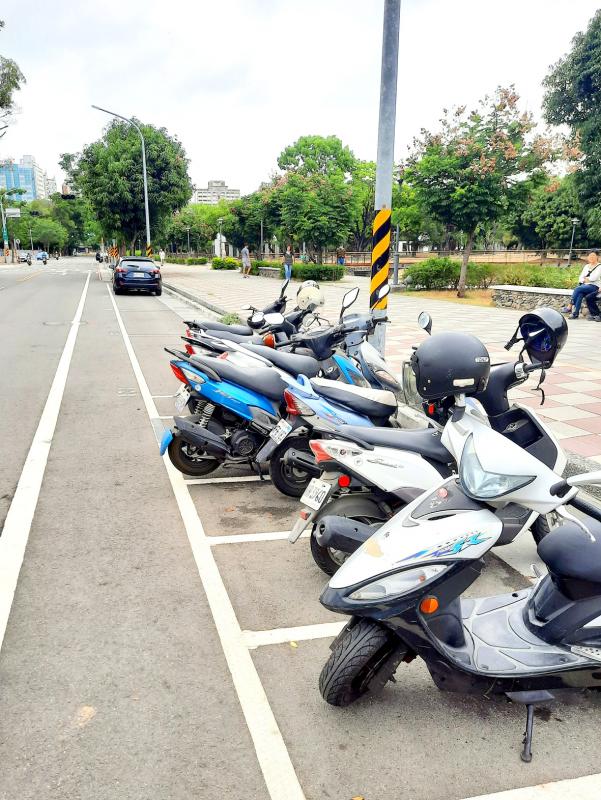People living in Taiwan’s cities hope for many things. Some might put cheaper housing or quieter neighbors at the top of their wish-list. Quite a few surely dream of more orderly, less congested roads.
To get an international perspective — and find out what a specialist thinks could be done to make driving and riding less stressful and the streets safer — I reached out to Chiu Bing-yu (邱秉瑜), a PhD student in City and Regional Planning at the University of Pennsylvania.
Chiu’s research focuses on how the supply of public transportation and land-use planning affect travel behavior, with particular attention to motorcycle use in Asia. A Taipei native, he has written scores of op-ed articles for Chinese-language newspapers and Web sites on topics related to traffic.

Photo: Lin Yi-chang, Taipei Times
When making cross-border comparisons, Chiu looks at countries where the nominal GDP per capita is within 10 percent of Taiwan’s. (He uses the nominal figure instead of purchasing power parity — which adjusts for the cost of living — because vehicles and fuel are internationally traded goods.) By this measure, Taiwan’s peers include South Korea, Spain, Italy, Cyprus and the UAE.
TOO MANY VEHICLES
With regard to traffic jams, Taiwan’s cities aren’t doing too badly. Chiu says that commuters in many countries, including wealthier nations, have it much worse. Kaohsiung, the only Taiwanese city on the 2020 INRIX Global Traffic Scorecard, last year recorded 27 hours lost to congestion.

Photo: Steven Crook
“Looking at cities in Taiwan’s peer countries, Italy’s worst is Rome with 66. In New York, the number is 100, and in Paris it’s 88,” he says.
In a piece for United Daily News published April 28 last year, Chiu stressed that the principal cause of traffic problems in cities, including the conflict between pedestrians and vehicles, is the sheer number of cars and motorcycles.
Of course, Chiu isn’t the first person to highlight this metric. In a 2013 paper in The Journal of the Eastern Asia Society for Transportation Studies, Tokyo-based scholars called vehicle numbers “one of the most pressing problems in [Taiwan’s] urban transportation environment.”

Photo: Steven Crook
They noted that between 1966 and 2008, the number of cars on the country’s roads multiplied 365 times to more than six million. In the same period, the number of motorcycles rose 154 times to over 14 million.
Some say car ownership will decline as the population ages, yet sales of new cars reached a 15-year high last year. The motorcycle industry also had a banner year.
The 2013 paper also points out that, for a long time, Taiwan’s policymakers assumed that motorcycles were merely a stage in the transition from a bicycle society to an automobile society. Probably influenced by those who’d studied in the car-dominated US, they assumed the number of motorcycles would shrink with economic growth and greater car ownership.
TRAFFIC FATALITIES
Every day, Taiwanese live with and die as a result of the consequences of this misreckoning. These include a lack of motorcycle parking slots, illegal parking on sidewalks and in fire lanes, and a great many accidents.
In terms of traffic-accident fatalities, Taiwan has a poor track record with 12.1 deaths per 100,000 population in 2016. Chiu points out that, while the traffic fatality rate is higher in the UAE (18.1 per 100,000), it’s lower in South Korea (9.8), Italy (5.6), Cyprus (5.1) and Spain (4.1). Japan recently recorded 4.1 road deaths per 100,000 residents.
Surprisingly, death-rate statistics suggest that roads in and around Taipei are far safer than those in rural places like Taitung, Pingtung and Yunlin.
Chiu says that the six local government divisions with the highest rates of deaths in traffic accidents are also Taiwan’s six poorest counties when measured by median household disposable income.
“This shows a possible negative correlation between income and traffic fatality rates, but there are counterexamples like Hsinchu County, where income is high but the fatality rate isn’t low,” he says.
Chiu thinks a more likely explanation for the phenomenon could be population density. Crowded streets lead to lower travel speeds; when accidents do occur, they’re less likely to be fatal. Public transportation is also important. Taipei and New Taipei have the most extensive metro and bus networks, and their traffic fatality rates are the lowest nationally, Chiu explains.
Enforcement of traffic laws is surely a factor, and it seems the rules are more strictly enforced in big cities. Chiu shares some 2016 statistics: That year, Taiwan’s six special municipalities reported 44,075 traffic violations per 100,000 population. For the rest of the country, the rate was 31,495 per 100,000 residents.
Kaohsiung has fewer road deaths per 100,000 than Tainan, which Chiu attributes to the former having better public transportation.
“The rate of motorcycle ownership doesn’t seem to strongly predict traffic fatality rates. For example, in 2016, Kaohsiung had a higher motorcycle ownership rate than Tainan. Also, New Taipei’s motorcycle ownership rate exceeds Taoyuan’s, but its traffic fatality rate is lower,” he says.
REDUCING PRIVATE VEHICLES
As Chiu concedes in his article last year, halting the gradual increase in total vehicle numbers is difficult. But, he argues, certain reforms would help society reduce its dependence on private vehicles. Roads should be designed, he says, to serve “pedestrians first, bicycles and public transportation second and private vehicles last… but current reality is contrary to this.”
To improve road safety, Chiu stresses the importance of reducing vehicle use by getting more people on buses and MRT trains, and lowering travel speeds.
To achieve this, he’d begin by introducing by-the-hour parking charges for all vehicles, including motorcycles.
The Taoyuan City Government has taken a step in this direction, and begun charging per hour at some motorcycle parking spaces. In the busier parts of both Tainan and Taipei, motorcycle-users must pay per-day parking fees.
Also, he recommends hiring contractors to uncover and report traffic violations.
“Currently, enforcement is the police’s job, and we can see how ineffective they are. Citizens are allowed to send photos to the police, but individuals’ efforts aren’t enough to right all the wrongs,” Chiu says.
In Taipei, contractors handle the towing of illegally parked cars and the administration of parking fees. Chiu doesn’t know of any countries where contractors have also taken over the work of catching those who speed or run red lights. He nevertheless thinks it could be better than the current system.
“We need to do more research, covering international best practices, legal issues, ethical issues and so on,” he says.
He also calls for increased government spending on bus services and sidewalks, as well as “smart growth” policies that would concentrate development and activities in close proximity to one another and to existing or planned metro stations and bus stops. By delineating urban growth boundaries, the authorities could limit sprawl and thereby reduce travel distances.
‘TRAFFIC CALMING’
Chiu also supports further “road diet” and “traffic calming” measures.
Examples of the former can be seen on Fuxing South Road (復興南路) and Xinsheng South Road (新生南路) in Taipei.
“The sidewalks were widened and new cycle lanes were put in place, resulting in fewer lanes and less space for vehicular traffic,” Chiu says.
Traffic calming aims to encourage more responsible driving. Last year, the Hsinchu City Government modified some of the city’s pedestrian crossings, replacing the standard black-and-white pattern with a blue, yellow and white scheme that’s more likely to get drivers’ attention.
Chiu says that, to the best of his knowledge, neither Taiwan’s central government nor any of the country’s local governments have seriously considered a “proof of parking space” rule like the one that limits car ownership in Tokyo. Since 1962, residents of Japan’s capital have only been allowed to buy a vehicle if they can show they’ve somewhere to park it.
Chiu agrees with specialists who believe that the “proof of parking space” rule only works well because overnight parking on streets is not allowed in many Japanese cities.
Contrasting the situation in Taiwan — where local governments have increased the supply of public parking spots — with that in Japan, Chiu says: “Public on-street parking spaces are scarce in Japan. Most parking lots there are off-street and commercial, and police enforcement against illegal parking is strict. Taiwan’s abundance of public on-street parking spaces and tolerance of illegal parking would need to be reformed before it could replicate Japan’s ‘proof of parking space’ rule.”
Steven Crook, the author or co-author of four books about Taiwan, has been following environmental issues since he arrived in the country in 1991. He drives a hybrid and carries his own chopsticks.
This column does not necessarily reflect the opinion of the Taipei Times.

June 23 to June 29 After capturing the walled city of Hsinchu on June 22, 1895, the Japanese hoped to quickly push south and seize control of Taiwan’s entire west coast — but their advance was stalled for more than a month. Not only did local Hakka fighters continue to cause them headaches, resistance forces even attempted to retake the city three times. “We had planned to occupy Anping (Tainan) and Takao (Kaohsiung) as soon as possible, but ever since we took Hsinchu, nearby bandits proclaiming to be ‘righteous people’ (義民) have been destroying train tracks and electrical cables, and gathering in villages

Swooping low over the banks of a Nile River tributary, an aid flight run by retired American military officers released a stream of food-stuffed sacks over a town emptied by fighting in South Sudan, a country wracked by conflict. Last week’s air drop was the latest in a controversial development — private contracting firms led by former US intelligence officers and military veterans delivering aid to some of the world’s deadliest conflict zones, in operations organized with governments that are combatants in the conflicts. The moves are roiling the global aid community, which warns of a more militarized, politicized and profit-seeking trend

The wide-screen spectacle of Formula One gets a gleaming, rip-roaring workout in Joseph Kosinski’s F1, a fine-tuned machine of a movie that, in its most riveting racing scenes, approaches a kind of high-speed splendor. Kosinski, who last endeavored to put moviegoers in the seat of a fighter jet in Top Gun: Maverick, has moved to the open cockpits of Formula One with much the same affection, if not outright need, for speed. A lot of the same team is back. Jerry Bruckheimer produces. Ehren Kruger, a co-writer on Maverick, takes sole credit here. Hans Zimmer, a co-composer previously, supplies the thumping

Dr. Y. Tony Yang, Associate Dean of Health Policy and Population Science at George Washington University, argued last week in a piece for the Taipei Times about former president Ma Ying-jeou (馬英九) leading a student delegation to the People’s Republic of China (PRC) that, “The real question is not whether Ma’s visit helps or hurts Taiwan — it is why Taiwan lacks a sophisticated, multi-track approach to one of the most complex geopolitical relationships in the world” (“Ma’s Visit, DPP’s Blind Spot,” June 18, page 8). Yang contends that the Democratic Progressive Party (DPP) has a blind spot: “By treating any